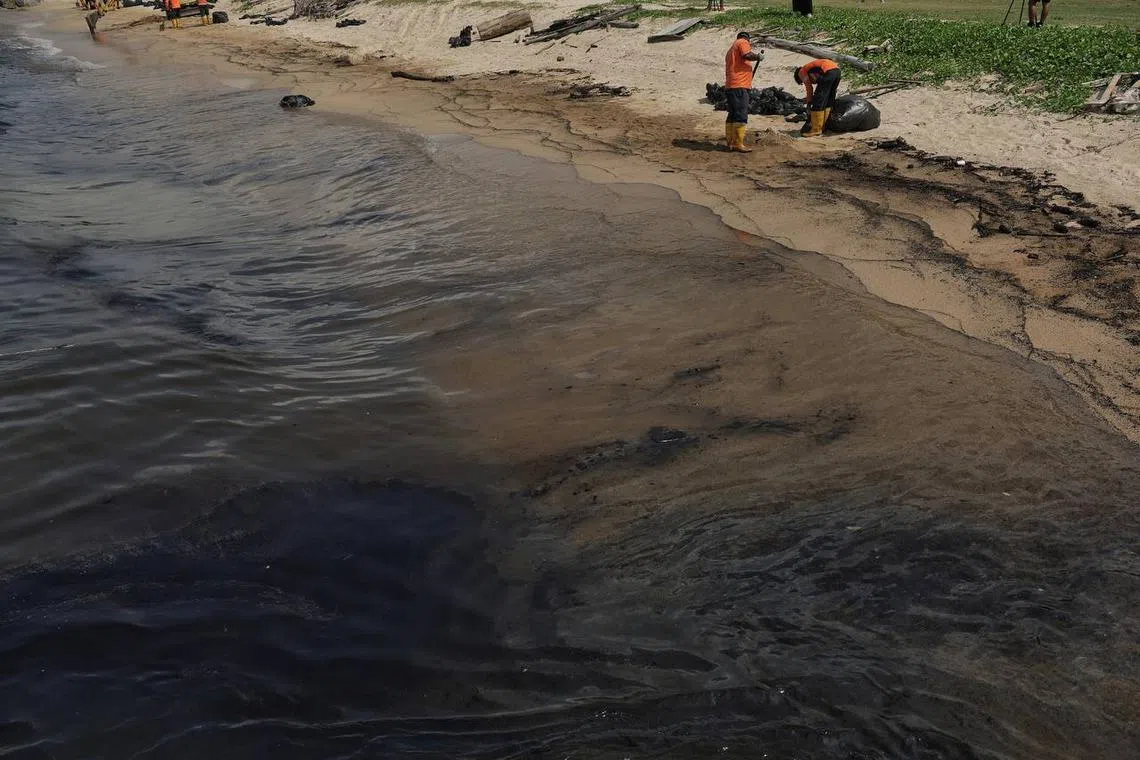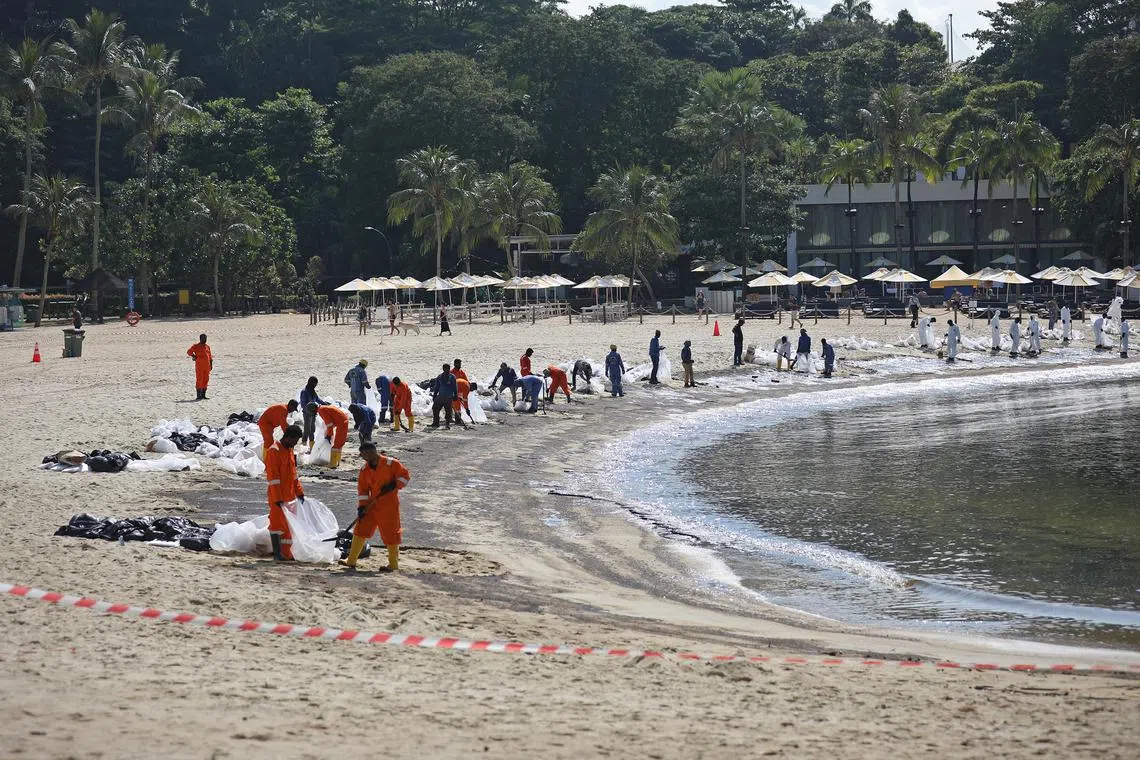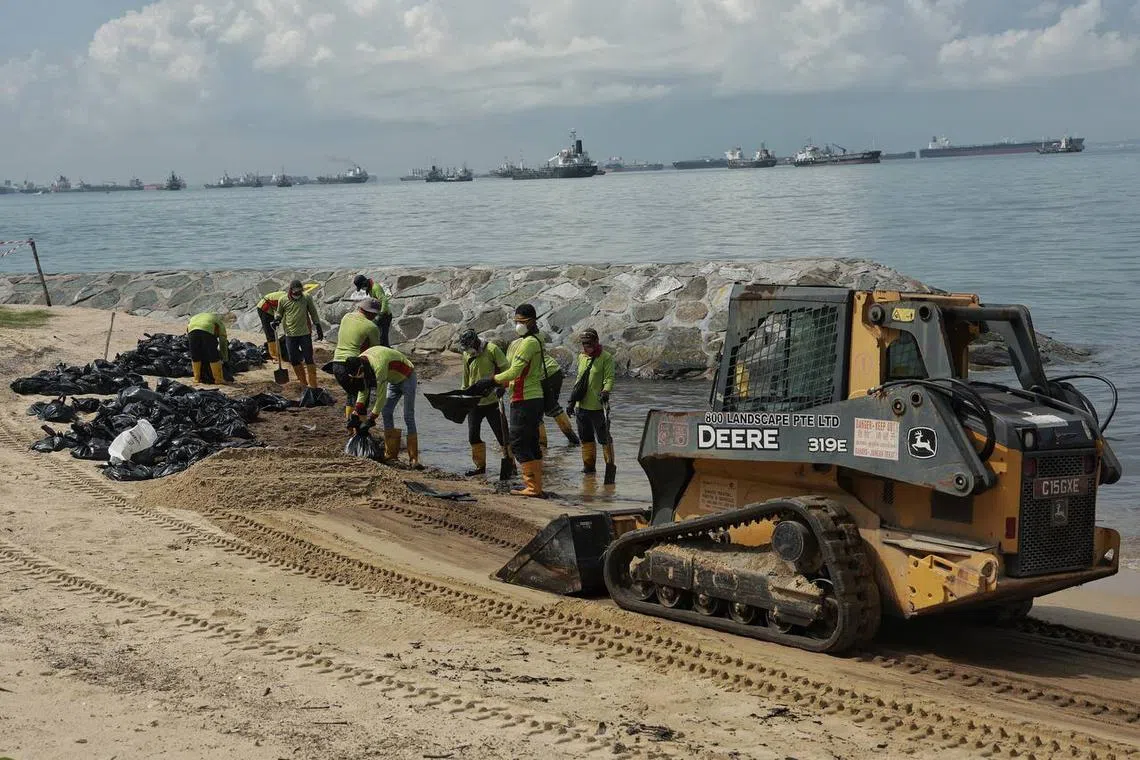Beaches at several southern islands, most of East Coast Park and Tanah Merah cleared of oil
Sign up now: Get ST's newsletters delivered to your inbox
Follow topic:
SINGAPORE - The beaches in Singapore’s southern waters and East Coast Park have been mostly cleared of oil as part of ongoing efforts to clean up the Republic’s biggest oil spill
As at 5pm on June 19, the beaches on St John’s, Lazarus and Kusu islands have been cleared of oily sand, the Singapore authorities said on June 20 in a joint statement on the progress of the operation.
The northern part of Pasir Panjang Terminal, where the June 14 incident occurred, has also been cleared of oil slicks. That day, a Netherlands-flagged dredging boat hit a Singapore-flagged bunker vessel at Pasir Panjang Terminal, causing 400 tonnes of fuel to leak into the sea
Oil deposits have been removed from most parts of Siloso beach on Sentosa, as well as the beaches at East Coast Park and Tanah Merah, said the agencies tackling the spill.
They are the Maritime and Port Authority of Singapore, National Environment Agency (NEA), National Parks Board, PUB, Sentosa Development Corporation, Singapore Food Agency (SFA) and Singapore Land Authority.
As tides could still sweep in remnants of oil deposits, further cleaning at East Coast Park and the beaches of Tanah Merah will likely be required, the authorities said.
Meanwhile, cleanup efforts at Sentosa’s Palawan and Tanjong beaches, and the removal of accumulated oil off Labrador Nature Reserve, Cooper Channel and Keppel Marina, are still under way.

Oil-stained rocks and sand at Labrador Nature Reserve near Carpark C at 4.45pm on June 18.
ST PHOTO: LIM YAOHUI
To date, no fish farms have been affected by the oil spill,
Similarly, national water agency PUB said Singapore’s drinking water supply remains unaffected, with water quality readings normal.
As Singapore races to limit damage from the oil spill, 3.4km of booms have been deployed
Three oil recovery and containment systems known as current busters have been deployed at affected areas at the terminal and off Sentosa, East Coast Park and Changi East, and another will join the operation shortly.
In total, these machines will be capable of siphoning 80 tonnes of oil per load.

Workers engaged by NEA cleaning up the oil spill at the beach in East Coast Park.
ST PHOTO: KEVIN LIM

The oil spill cleanup taking place on June 14 at Tanjong Beach.
ST PHOTO: LUTHER LAU
As at 5pm on June 19, no oil has been observed at Changi and Pasir Ris beaches, but the public is still advised against engaging in water activities until further notice.
Likewise, no oil has been spotted off West Coast Park and biodiversity-sensitive areas at Chek Jawa Wetlands on Pulau Ubin, Coney Island Park and Pasir Ris Park.
Still, absorbent booms that can contain and soak up oil have been deployed to shield these sites.
The beaches that have been affected so far will continue to be monitored for further signs of oil slicks, the authorities said.
Transport Minister Chee Hong Tat said in a Facebook post on June 20 that the cleanup will take some time, and sought the understanding of members of the public and businesses affected by the incident.
At the moment, air quality at the affected areas at East Coast Park, Labrador Nature Reserve and on Sentosa remains well within safe levels, but the NEA will continue to monitor the affected areas to ensure the public and personnel involved in the cleanup remain safe.
The Singapore authorities are in touch with the Malaysian government to cooperate on efforts to address any further impact of the oil spill, the joint statement added.
Singapore, Malaysia and Indonesia are part of the Revolving Fund Committee, where the three countries can request and provide support for oil spills and cleanup operations in the Malacca Strait and Singapore Strait.
The fund was set up in 1981 with an initial 400 million yen deposit from the Malacca Strait Council, which is backed by Japan’s government and its maritime community.
Amounts drawn must be repaid to the fund when the country recovers the cleanup costs from the parties responsible.
The last time a large amount of oil leaked into Singapore’s waters was in 2014. That year, three ship collisions in January and February caused a total of 760 tonnes of fuel to pollute Singapore’s waters.

Workers and a skid loader engaged by NEA to clean up the oil spill at the beach in East Coast Park.
ST PHOTO: KEVIN LIM
In 2010, a tanker collided with a bulk carrier off Changi’s coast, dumping some 2,500 tonnes of crude oil into the waters. The slick spread to Chek Jawa and sparked the closure of beaches in Changi, East Coast Park and Pasir Ris for more than a week.
The Republic’s largest oil spill occurred in 1997, when over 28,000 tonnes of marine fuel spilt into the Singapore Strait after two tankers collided. It took 650 men and 90 anti-pollution craft three weeks to clean up the oil.


